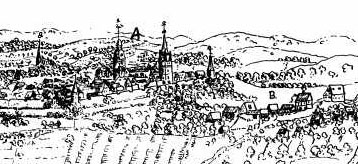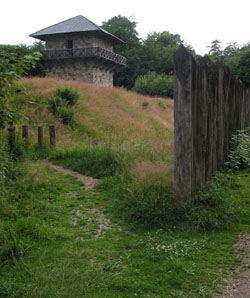Niedernhausen, Groß Bieberau, and Reinheim, Hesse-Darmstadt

The town of Reinheim in Hesse-Darmstadt is pictured at right as it looked in 1697, drawn by L. Zoller. For almost three hundred years from the 1500s through the 1800s its church, as well as parishes nearby like Niedernhausen and Groß Bieberau, provided records for our earliest known ancestry in this region, with details of our earliest documented Schuchmann ancestor, Hans Schuchman, his marriage, his children and grandchildren, and numerous descendants. Early on the name was spelled with just one final "n".
Hans Schuchman der Junge "the Younger", born about 1550, married Anna Funck, daughter of Philip Funck, in 1576. One of their sons was Hans, born on 15 November 1579. He was married to Dorothea (no surname available) around 1599. Their son Peter was born at the end of 1604 in a village called Hausen or Niedernhausen. Peter was living in Reinheim when he married Anna Rimhopf in 1630. Their marriage record is at right.
Anna died around 1634 and Peter then married a widow, Margaretha Wasenmüller. He and Margaretha had thirteen children togther, including one set of twins and one set of triplets!
The family lived through times of great peril. This was during the height of the Thirty Years War, when soldiers and marauders ran rampant over the countryside. During the years 1634-1636 lootings and beatings were almost an everyday occurrence, and pestilence and famine devastated families. A local village, Überau, had been so badly burned that it was uninhabitable for ten years. Peter Schuchmann's home village, Neidernhausen, was completely depopulated.

Displaced local inhabitants came to Reinheim to record their births, marriages, and deaths. A list of survivors of the period was made by the pastor of Reinheim who noted that 33 refugees from Überau joined the 77 citizens of Reinheim. The Schuchmanns lived in Reinheim for most of the early to middle 1600s, resettling in Überau only after the conclusion of the war in 1648.
Peter Schuchmann was a citizen-juror and fund manager (probably for the church in Reinheim), but his common name was "Gerber-Peter", or Peter the Tanner. Perhaps his father or grandfather had been a leather worker at one time. His and Margaretha's last child, a son called Johann (Hans) Georg, was born in 1654. Johann Georg became a tailor, eventually a "Schneidermeister," a master-tailor.
For those interested, another son, Wendel Schuchmann, born in 1639 and married in 1661, was the ancestor of a group of Schuchmanns who emigrated in the 1830s to St. Clair County, Illinois. If any of those folks would like to share images, stories, and DNA from your clan, our clan would welcome it!
As occasionally happened during this era (and in every era), Johann Georg and a young lady set up housekeeping without the benefit of marriage. He and Elisabetha Wembfen had a daughter in 1681 before being persuaded to marry in 1682. The marriage record indicated that they had to pay a "penance tax" to the church to smooth the way toward matrimony. Their son, also called Johann Georg, was born in 1683.
In 1709 Johann Georg Schuchmann "the younger" married Elisabetha Margaretha Kneskern, daughter of Johann (Hans) Jacob Kneskern and Maria Veronica Forch. In 1710, after a devastatingly cold winter, a brother of Elisabetha Margaretha, Johann Peter Kneskern, emigrated to New York, which was then part of the thirteen British colonies. Everyone in the USA with the surname Kneskern or Kniskern is said to be descended from Johann Peter's line. Johann Georg Schuchmann's family, however, remained in Reinheim.
The Schuchmann-Kneskern family produced five daughters and one son. The son, predicably, was named Johann Georg. At Johann Georg's birth in 1729 one of his godparents was his paternal grandfather, Johann Georg Schuchmann. The other was Johann Daniel Kneskern, his mother's brother or cousin.
Johann Georg was confirmed in Reinheim in 1743 and married Maria Catharina Becker, daughter of Johann Valentin Becker, on December 5, 1754. Like his father and grandfather, Johann Georg was a tailor. His son Georg Philipp, born in 1766, expanded that trade and specialized in haberdashery, principally lace and braid-making. Click this link to read more about the Schuchmanns and their eventual emigration to America.